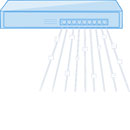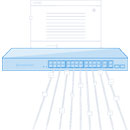
Networks for small- to medium-sized businesses.
Internet Provider
An Internet service provider, or ISP, is a company that brings an Internet connection into your home, allowing your devices to get online. The different types of ISPs and the Internet subscription plans they offer vary depending on where you live.

Modem
A modem lets the devices in your home use an ISP’s signal for connecting to the Internet. Modems receive the incoming ISP signal through a cable. They can then connect directly to a device you want to get online, like a computer or game console, using an Ethernet cable.
Since most homes have more than one device that needs an Internet connection, and modems can only have one direct connection at a time, another device is often needed to build a fully connected home—a router.
Router
Routers are able to connect to many devices at once, letting them communicate with each other and connect to the Internet through your modem. A router is the backbone of most connected homes. There are many different types of routers, but the most important difference between them is whether they are wired or Wi-Fi.

Wired Router
A wired router can only connect to devices using Ethernet cables, meaning the most connections it can have at the same time is equal to the number of Ethernet ports it has. Gigabit Ethernet ports run up to 10x faster than standard ones for better overall performance. Generally speaking, wired connections are faster and more stable and than wireless ones.

Wireless Router
Wi-Fi routers connect to devices without an Ethernet cable by creating a wireless signal. The stronger a router’s wireless signal, the farther it can reach across your home and the faster and more reliable your devices’ Wi-Fi connections can be. Wi-Fi routers can usually connect to many more devices at once than wired routers. They also create more flexible connections, since they can link to devices in other rooms wirelessly.

Wi-Fi Types
Wireless AC is a newer Wi-Fi technology than Wireless N and offers better overall performance, particularly speed and range. Wireless AC routers can run up to three times faster than Wireless N routers, and their Wi-Fi bands can reach farther than the bands of Wireless N routers.
AC routers can also connect to more devices at once than N routers, making them perfect for homes with many Internet users. AC routers are also backwards compatible, which means that all wireless devices, even older ones, can still connect to a Wi-Fi network created by an AC router.

Wi-Fi Bands
Wireless AC is a newer Wi-Fi technology than Wireless N and offers better overall performance, particularly speed and range. Wireless AC routers can run up to three times faster than Wireless N routers, and their Wi-Fi bands can reach farther than the bands of Wireless N routers.
AC routers can also connect to more devices at once than N routers, making them perfect for homes with many Internet users. AC routers are also backwards compatible, which means that all wireless devices, even older ones, can still connect to a Wi-Fi network created by an AC router.

Why Speed Matters
For streaming, a faster Internet connection means you can watch movies in higher quality with less loading. For game consoles, it means not lagging when playing online with friends. Even lighter activities benefit from speedy connections—web pages open faster, and emails send more quickly.
Why Strength Matters
The stronger a router’s wireless signal, the faster and more reliable its connections with devices can be. Plus, a stronger Wi-Fi signal isn’t as weakened by obstacles like walls and interference from other electronics. Overall, stronger Wi-Fi lets you connect to the Internet faster and farther from your router.

Range Extender
A range extender connects wirelessly to your router and repeats its Wi-Fi signal wherever it’s set up, making your coverage stronger in that area. Though range extenders must be within your router’s signal area to work, they can often extend your router’s Wi-Fi to “dead zones,” which are areas it can’t reach on its own.
You can use multiple range extenders at the same time to bring stronger wireless coverage to different rooms. They typically install quickly and can even copy your router’s name and password automatically for easier use.

Powerline
Powerline adapters work by connecting to your router through an Ethernet cable and then plugging into a nearby wall outlet. This allows them to turn your home’s electrical wiring into a reliable, high-speed extension of your router. You can then plug other Powerline adapters into any outlets in your home to create instant Internet access.
Powerline is perfect for extending your router’s coverage far outside its Wi-Fi range, especially into hard-to-reach areas like your basement or attic. Some Powerline adapters only connect to your devices with an Ethernet cable. Others can create Wi-Fi coverage in the areas they’re placed, giving them the ability to also connect to devices wirelessly.

Wi-Fi Adapters
While many computers have built-in Wi-Fi connectivity, older models may not be able to take advantage of the higher speeds offered by newer Wi-Fi technology. Wi-Fi adapters create stronger connections with your router to let your computer reach the fastest speeds possible. One of the most important differences between Wi-Fi adapters is how they connect to your computer.
A USB adapter is easy to install, and plugs directly into any open USB port. While convenient to use, USB adapters tend to be less powerful than PCIe adapters, which are better suited for activities like gaming online and streaming video in high quality. However, PCIe adapters must be directly connected to your computer’s motherboard, which requires you to remove your computer’s outer casing.

Networks for medium to large sized businesses.

Network Switch
The most important element of a business network is a switch. Switches allow all of a business’s devices, like computers, printers, and servers, to communicate with one another. This increase in information sharing helps businesses operate with greater efficiency.
It’s important to understand the difference between network switches and routers. A router connects existing networks, for example allowing your devices to link to the Internet. A switch actually creates its own network, across which devices can share information. There are several types of switches, each designed to meet different needs.

Unmanaged Switch
Unmanaged switches work right away with no configuration required. They create a network with less capacity than other types of switches, making them best suited for basic use in smaller business settings.

Smart Switch
Smart switches support simple functions, including VLAN, MAC address binding, and rate limit setting. They are user-friendly, and can be configured through a web interface. Though smart switches have fewer features than managed switches, they are less expensive and can accomplish more than unmanaged switches can.

Managed Switch
Managed switches support a full range of networking functions and are the most customizable through various interfaces. They help larger businesses handle network loops, advanced security, and multiple VLAN. When looking to build a strong, adaptable network for a larger setting, managed switches are an excellent choice.

Access Point
An access point is a device that extends the reach of a business’s network, allowing more devices to connect to it through Wi-Fi. Though similar to range extenders, access points differ in a crucial way. Range extenders recreate a Wi-Fi signal that already exists, and access points can each create their own original Wi-Fi signal wherever they are installed. This feature makes it possible for access points to bring Wi-Fi to any area of a business where a wired connection already exists.

